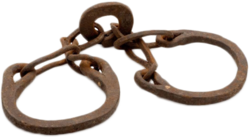
Back العبودية في أمريكا اللاتينية Arabic بردهداری در آمریکای لاتین Persian Латин Америк дахь боолчлол Mongolian Afriški sužnji v Latinski Ameriki Slovenian 拉丁美洲黑奴制 Chinese
This article needs additional citations for verification. (July 2014) |
| Part of a series on |
| Forced labour and slavery |
|---|
 |
Slavery in Latin America was an economic and social institution that existed in Latin America before the colonial era until its legal abolition in the newly independent states during the 19th century.[1] However, it continued illegally in some regions into the 20th century.[2] Slavery in Latin America began in the pre-colonial period[3] when indigenous civilizations, including the Maya and Aztec, enslaved captives taken in war.[4] After the conquest of Latin America by the Spanish, Portuguese and French, From the 1500s to the 1800s, merchants transported approximately 12 million Africans across the Atlantic as human property. The most common routes formed what is now known as the "Triangle Trade," connecting Europe, Africa, and the Americas. From 1560 to 1850, about 4.8 million enslaved people were transported to Brazil; 4.7 million were sent to the Caribbean; The European demand for African captives in mainland Spanish America (not including Spanish-Caribbean)began during the conquest and settlement of the New World. This labor demand quickly became a part of the global forced movement of captive Africans. During the colonial period, from the 1500s to the mid-19th century, over 12.5 million captives arrived in the Americas from Africa, primarily West Central Africa. For Mainland Spanish America (not including Spanish-Caribbean), approximately 2,072,300 people endured the transoceanic and intra-American slave trades and disembarked at Atlantic-facing ports in the mainland of this region, With Spanish Central America acquiring 1.3 million enslaved Africans [1] [2](Another at least 800,000 enslaved africans were later sent to mainland Spanish America through other colonies in the Americas such as Jamaica and Brazil). [3]; At least 388,000, or 4% of those who survived the Middle Passage, arrived directly from Africa to present day United States. [4]
After the gradual emancipation of most black slaves, slavery continued along the Pacific coast of South America throughout the 19th century. Peruvian slave traders kidnapped Polynesians, primarily from the Marquesas Islands and Easter Island, and forced them to perform physical labour in mines and the guano industry of Peru and Chile.[5]
Today, Latinos across the Americas have differing proportions of Native American, African, and European genetic ancestry, shaped by local historical interactions with migrants brought by the slave trade, European settlement, and indigenous Native American populations. [5] Genetic studies show that the majority (75% or 520-560 Million people) who identify as Hispanic/Latino carry at least some degree of West and Central African ancestry.
- ^ ":: Welcome to Born in Blood & Fire - Second Edition - Student Website ::". wwnorton.com. Retrieved 2022-10-12.
- ^ "Emancipation in Latin America and the Caribbean | Encyclopedia.com". www.encyclopedia.com. Retrieved 2022-10-12.
- ^ Schmidt-Nowara, Christopher (2011-06-22). Slavery, Freedom, and Abolition in Latin America and the Atlantic World. University of New Mexico Press. ISBN 978-0-8263-3905-8.
- ^ Burkholder, Mark A.; Johnson, Lyman L. (2019). Colonial Latin America (Tenth ed.). New York: Oxford University Press. pp. 10, 15. ISBN 978-0-19-064240-2. OCLC 1015274908.
- ^ Maude, Henry Evans (1981). Slavers in paradise: the Peruvian labour trade in Polynesia, 1862-1864.
© MMXXIII Rich X Search. We shall prevail. All rights reserved. Rich X Search